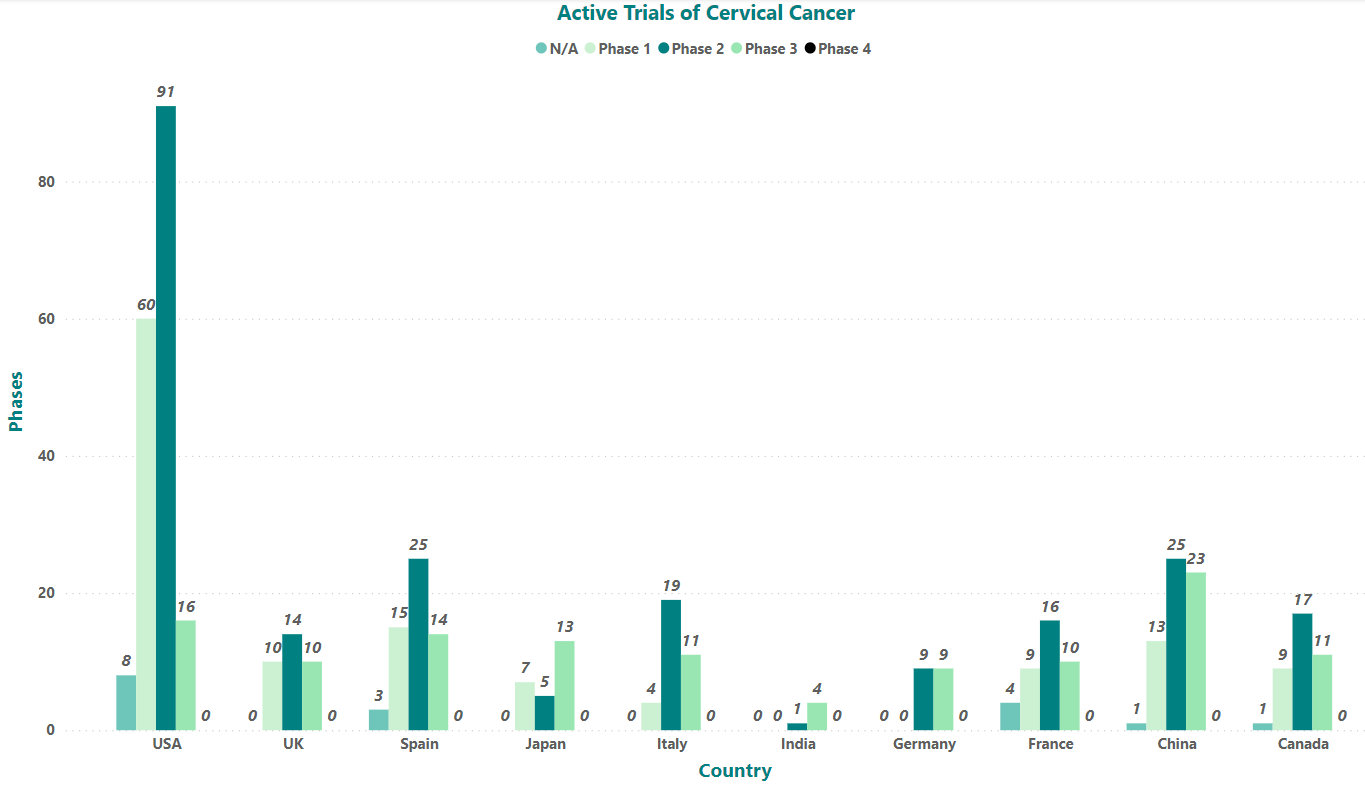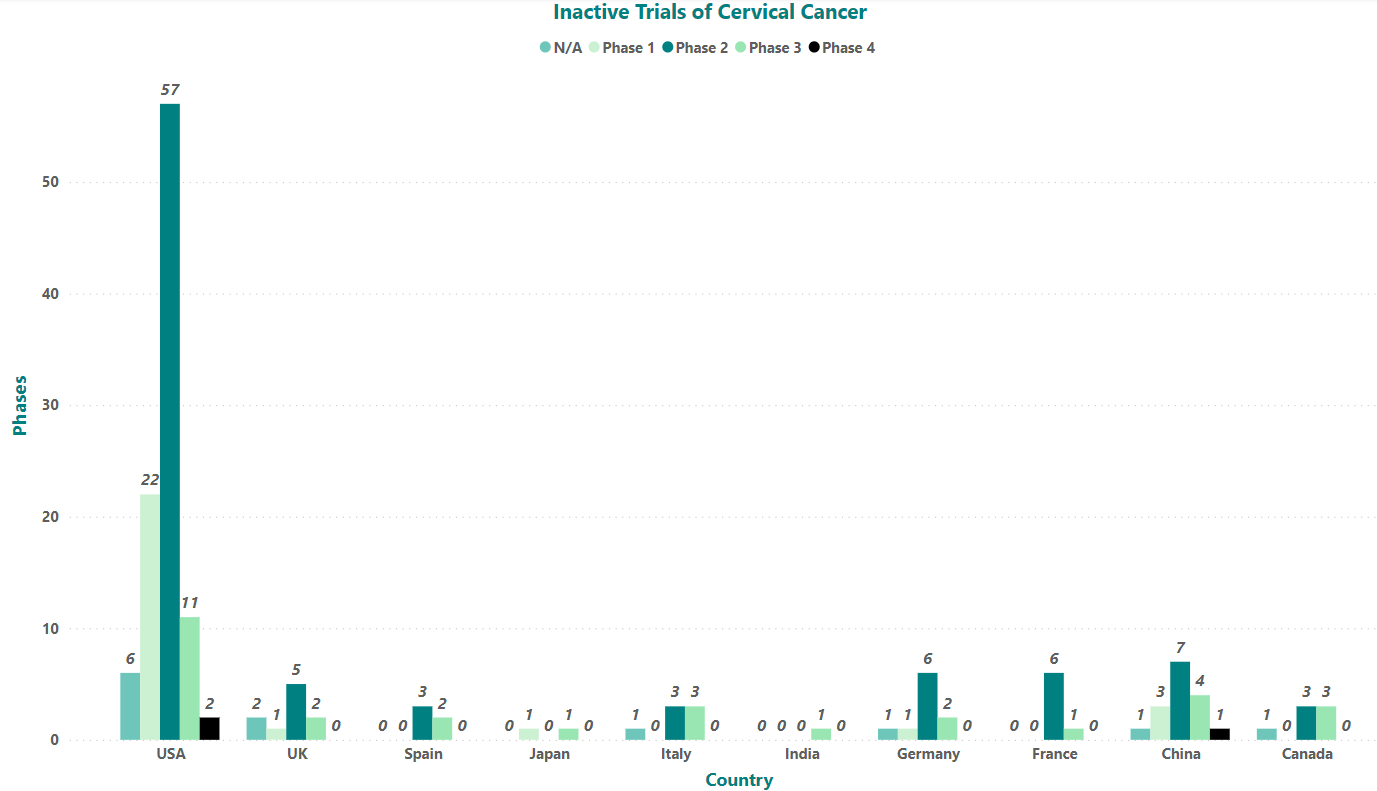
Disease of the Month: Cervical Cancer
“Get Informed, Get Screened, Get Vaccinated” – WHO
Introduction:
Cervical cancer is the 4th most common cancer among women and 7th most commonly occurring cancer overall. When a malignant growth or tumor occurs in the cells lining the walls of the cervix, it is called cervical cancer. The cervix is the narrow, lower part of the uterus connecting it to the vagina (birth canal). It is covered with two different types of cells, the innermost canal-like structure (Endocervix) and the outermost part of the cervix (Ectocervix)
The site at which both types of cells meet inside the cervix is called the transformation zone. The squamous cells in the transformation zone are the beginning point in most cervical cancers. Typically, cervical cancer progresses gradually over time. Before cancer develops in the cervix, the cells undergo changes called dysplasia (when abnormal cells start to emerge in the tissue). If left unnoticed or untreated, the abnormal cells may eventually develop into cancer cells and spread deeper into the cervix, and to nearby tissues.
The two main types of cervical cancer are, squamous cell carcinomas (80%- 90%) and adenocarcinomas (10% to 20%)
Risk Factors:
Cervical cancer is a risk for anyone with a cervix. People over 30 years are more likely at risk of being affected. The most common cause of almost all cervical cancers is a persistent infection with a certain variant of Human Papillomavirus (HPV), a common virus that is transmitted through sexual contact. In majority of HPV-infected women, the virus may disappear on its own, but in case it doesn’t, there is a potential that it could eventually lead to cervical cancer.
Other risk factors include:
- Other STIs – people infected with other sexually transmitted infections like gonorrhoea, syphilis, chlamydia, or HIV/AIDS have increased chances of developing HPV which in turn increases the risk of cervical cancer
- Smoking Tobacco is linked to squamous cell cervical cancer
Symptoms:
Cervical cancer in its early stages may cause no signs and symptoms which makes it hard to detect. Symptoms usually appear once cancer has spread.
Symptoms of early-stage cancer include:
- Vaginal bleeding after intercourse
- Vaginal bleeding between periods or after menopause
- Heavier or longer menstrual cycle
- Pelvic pain or pain during sex
- Watery or bloody vaginal discharge with a foul odour
Symptoms of advanced-stage cancer include symptoms of early-stage cancer along with:
- Mild backache
- Fatigue
- Painful urination or blood in the urine
- Abdomen pain
- Swelling in legs
- Difficult or painful bowel movements
Diagnosis:
In case an individual suspect some of the above-listed symptoms, screening tests like HPV test and Pap tests are performed to help prevent or early diagnose cancer. If screening test results are suggestive of the possibility of cervical cancer, the doctor will perform some follow-up tests to confirm the same. The process will start with the collection of your personal information including your family history and a physical exam including a rectovaginal exam and pelvic exam will be performed. The following procedures are done to diagnose cervical cancer:
1. Colposcopy
In this process, a speculum is inserted into the vagina by the healthcare professional to view the cervix. The abnormal areas are detected by applying the vinegar solution. The healthcare provider then places a colposcope which has bright light and magnifying glass close to the vagina to look at the cervix closely. The process usually includes a biopsy.
2. Biopsy
In a biopsy, a pathologist removes a sample of tissue from the cervix to examine it under a microscope for signs of cancer. The types of biopsies used to check cervical cancer include punch biopsy, endocervical curettage, loop electrosurgical excision procedure (LEEP) and cone biopsy
Epidemiology:
According to WHO statistics related to cervical cancer, ~604,000 women had been diagnosed with cervical cancer and nearly 342,000 died from the disease in 2020 globally. The majority of these cases and deaths (~90% for both) occurred in low- and middle-income countries.
Market Size:
According to recent market reports, the expected global market size of cervical cancer is to increase from $5.5B to $7.92B at a CAGR of 4.14% during 2021-2030

Treatment:
Surgery, chemotherapy, radiation therapies, immunotherapies etc are the different forms of treatment.
- Surgery- Cryosurgery, laser ablation, and conization can be used in cervical pre-cancers, and simple hysterectomy, radical hysterectomy, trachelectomy, and pelvic exenteration are some of the surgeries performed for invasive cervical cancer
- Radiation Therapy- these make use of high-energy x-rays to destroy the cancer cells. Radiation therapy is selected on the stage of cancer. Some type of radiation therapy for the treatment of cervical cancer are external beam radiation and brachytherapy.
- Chemotherapy- Some of the chemo drugs used in the treatment are cisplatin (IV) given (QW) or cisplatin along with 5-fluorouracil (Q3W) during radiation. Along with all these combinations of cisplatin, topotecan, taxol, or carboplatin can also be used in metastatic or recurrent cervical cancer
- Immunotherapy: Avastin by Roche and its biosimilars such as Vegzelma (Celltrion), Alymsys (Amneal), Mvasi (Amgen) are among the approved drugs in combination with chemotherapy regimens: paclitaxel and topotecan or paclitaxel and cisplatin. According to the recommendation, Avastin/ Vegzelma are IV administration at 15mg/kg of the body weight and is given Q3W. Keytruda (Merck) is another immunotherapy approved in combination with chemotherapy, ± bevacizumab for tumors express PD-L1 (CPS ≥1), also as a monotherapy for patients progressed on or after chemotherapy whose tumors express PD-L1 (CPS ≥1) as IV administration at 200mg Q3W or 400mg Q6W
Key Players in the Market:
Top Key players in the global market having approved drugs for the treatment of cervical cancer includes Amneal Pharma, Roche, Merck, Amgen, Novartis etc.

*The above-mentioned table include some of drugs approved in the US and the EU
Clinical Trial Analysis:
Experiments are ongoing on various cell therapy approaches including tumor-infiltrating lymphocyte (TILs) therapy that provokes a natural immune response against human papillomavirus. Iovance Biotherapeutics (LN-145 + Keytruda) is one in this space.
Various therapies (biologicals, chemotherapies or various combination) are under development/trials are ongoing for the treatment of cervical cancer. Qilu Pharmaceutical (QL1706), Akeso (AK104), AstraZeneca (durvalumab), BeiGene (tislelizumab), Biocad (BCD-100), Advaxis (ADXS11-001), Qurient (Q702) etc. are some of the leading players in the race of development
Based on G10 geography distribution, the interventional clinical trials are classified in the below mentioned graph in two groups based on its status i.e., active (recruiting, active, not recruiting, not yet recruiting and enrolling by invitation) and inactive (withdrawn, suspended terminated and trials with unknow status). The interpretation showed that highest no. of trials being conducted in the US and the least number of trials are reported in India (as represented in the graph)


*This graphical interpretation is based on our point of view of the clinical data
Government Programs:
1. National Breast and Cervical Cancer Early Detection Program (NBCCEDP)
The Breast and Cervical Cancer Mortality Prevention Act of 1990, approved by congress to increase access to breast and cervical cancer screening, directed CDC to establish the National Breast and Cervical Cancer Early Detection Program (NBCCEDP). All 50 states, 2 U.S. territories, 5 U.S.-affiliated Pacific Islands, the District of Columbia, and 13 American Indian and Alaska Native tribes or tribal organizations are eligible to apply for awards under the NBCCEDP.
The purpose behind CDC initiating NBCCEDP is to make timely breast and cervical cancer screening, diagnosis, and treatment services accessible to those with inadequate insurance and low incomes. In addition, NBCCEDP also offers patient navigation services assisting patients to obtain prompt quality care without any barriers.
NBCCEDP since 1991 has successfully-
- Provided service to >6.1 million women
- Delivered more than 15.7 million cervical and breast cancer screening examinations
- Identified 5,114 invasive cervical cancers and 235,396 premalignant cervical lesions, of which 39% were high-grade
- Diagnosed 24,024 premalignant breast lesions and 75,961 invasive breast cancers.
2. Cervical Cancer Elimination Initiative – Knowledge Repository
To encourage the member states in implementing Global Strategy, the cervical cancer elimination initiative had been established by WHO. For guidance, there are a variety of sites offering pertinent information among which the Knowledge Repository is a web-based platform that seeks to map and enable "one-stop" access to the knowledge gathered from a range of sources.
The WHO planned, all nations must achieve and sustain an incidence rate of less than 4 cases per 100,000 women in order to completely eradicate cervical cancer. Three crucial pillars and their accompanying targets are necessary to achieve that goal:
- Vaccination: complete HPV vaccination of 90% of girls by the age of 15
- Screening: high-performance test screening of 70% of women by the of 35, and then again by age of 45
- Treatment: 90% women with pre-cancer been treated and 90% women with invasive cancer been managed
In order to put each nation on the path of eradicating cervical cancer within the next century, they must reach the 90-70-90 targets by 2030.
References:
- AACR Journals
- ClinicalTrials.gov
- GlobeNewswire
- WHO
- CDC
- NIH
- Vegzelma
- American Cancer Society
- NBCCEDP Program
- Cervical Cancer Elimination Initiative
Related Post: Disease of the Month: AIDS | PharmaShots
Tags

Akanksha was a content writer at PharmaShots. She is interested in covering recent innovations from pharma & medtech industry. She covers news related to Product approvals, clinical trial results, and updates. She is passionate, meticulous, diligent, and inquisitive. She can be contacted at connect@pharmashots.com.














